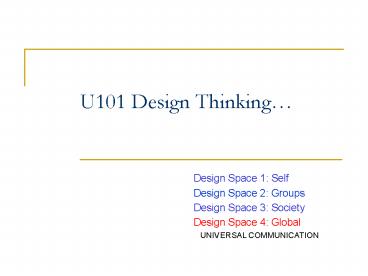U101 Design Thinking - PowerPoint PPT Presentation
1 / 14
Title: U101 Design Thinking
1
U101 Design Thinking
Design Space 1 Self Design Space 2
Groups Design Space 3 Society Design Space 4
Global UNIVERSAL COMMUNICATION
2
UNIVERSAL COMMUNICATION
U101 Design Thinking
Communicatingwith Graphics
Incomplete early draft!
Design Space 4
3
UNIVERSAL COMMUNICATION
U101 Design Thinking
Communicatingwith Graphics
- Aims
- 1. To stimulate your interest in, and increase
your awareness of the use of graphics as
universal communication devices - 2. To develop your ability to appraise critically
the use of graphics as a means of informing
people - 3. To develop your skills in creating
appropriate and informative graphics for
universal communication.
Design Space 4
4
U101 Design Thinking
UNIVERSAL COMMUNICATION
What do you think this is? What do you think it
represents?
Design Space 4
5
U101 Design Thinking
UNIVERSAL COMMUNICATION
Here is some colour differentiation to help. It
could perhaps be a tapestry a woven wall
hanging or carpet. Perhaps the most easily
recognised part of it is what appears to be a
simple representation of a human being about
three-quarters of the way down it. But then what
is the figure at the bottom? A monster? A dalek
from outer space? And if these two parts of the
overall pattern are indeed representations of a
human being and some other being, what do all the
other shapes represent?
Design Space 4
6
U101 Design Thinking
UNIVERSAL COMMUNICATION
The patterns of dark and light, or solid and
void, or ones and zeros, are, in fact, not just
patterns, but form a message. It was a message
sent out as a set of radio pulses from Earth into
space in 1974. The radio pulses were just a set
of on/off pulses (or ones and zeros). The
repeating pattern comprises 1679 such pulses.
1679 is the product of two prime numbers, 23 x
73. If the pulses are translated or reinterpreted
into a 23 x 73 grid array and represented
graphically as dark/light cells in the array,
then the result is as shown. Contained within
that graphic display is indeed a representation
of a human being but the being at the bottom
is a representation of the Arecibo radio
telescope from which the message was sent.
Design Space 4
7
U101 Design Thinking
UNIVERSAL COMMUNICATION
Another example of a message sent from Earth a
metal plaque aboard the Pioneer 10 spacecraft,
sent on its way out of the solar system towards
possible capture by other beings. The plaque is
engraved with graphic images, some of them with
the same meaning as the Arecibo radio message. Do
you recognise the two human beings? Do you think
they represent typical human beings? Do you
recognise their peaceful body language? Do you
think other beings, somewhere in outer space,
would recognise the same things?
Design Space 4
8
U101 Design Thinking
UNIVERSAL COMMUNICATION
Despite the problem of shared meanings between
Earthlings and Otherlings, graphic
representations were used in both the Arecibo
message and the Pioneer plaque in attempts to
communicate with beings who could not be expected
to share any other language with us. Graphics
therefore seem to have a potential for
communicating across time and space and culture.
Design Space 4
9
U101 Design Thinking
UNIVERSAL COMMUNICATION
But there are obvious limitations to the
complexity and subtlety of messages that can be
conveyed by graphics that is why we use verbal
and written communication so much more
extensively than graphics. Western forms of
writing have apparently developed from graphic
means of recording and communicating messages,
such as hieroglyphics. Some other forms of
writing, such as Chinese, are quite closely based
on underlying graphical representations of
meaning.
Design Space 4
10
U101 Design Thinking
UNIVERSAL COMMUNICATION
As international travel and cross-cultural
communication increases, there is an increase in
the use of graphics instead of, or as a
supplement to, writing. This is particularly
evident in places such as airports, where graphic
devices are increasingly used on directional and
other information displays, and are increasingly
becoming internationally standardised. But
cultural differences can still lead to
misunderstandings, and the meaning of each symbol
or image is still something that is learned
experienced travellers recognise the meaning of
more of the graphic devices than do inexperienced
travellers.
Design Space 4
11
U101 Design Thinking
UNIVERSAL COMMUNICATION
Where it is necessary to communicate to people
who have different languages, graphics can be
used as a language-free medium. For example,
the Swedish company IKEA uses only pictures
(sometimes including numbers, but no words) to
communicate the assembly instructions for its
furniture, sold throughout the world.
Design Space 4
12
U101 Design Thinking
UNIVERSAL COMMUNICATION
Observation Activity Look around you for
examples of everyday uses of graphic devices. Are
their meanings obvious, or have you learned the
meanings? Record some examples (draw, photo,
scan). Share with other students.
Design Space 4
13
U101 Design Thinking
UNIVERSAL COMMUNICATION
Highlight on Resources There are many -
especially Tufte.
Envisioning Information, Tufte
Find it on Amazon
Beautiful Evidence, Tufte
Find it on Amazon
Design Space 4
14
U101 Design Thinking
UNIVERSAL COMMUNICATION
? Design Task Students are asked to create
graphics as substitutes for words (e.g.
converting written instructions to graphical
ones) and data (e.g. converting tables to
graphs/charts). Possibles Menu aids
(starter/main course/dessert) Slow-food
restaurant Signs for new international
situations internet cafe, electric car
recharging point, recycling - separation of
materials, child-safe area, lost baggage
Design Space 4































